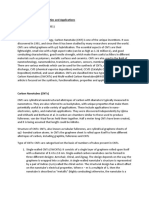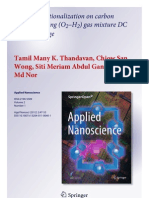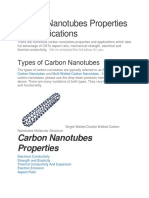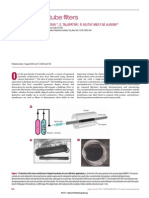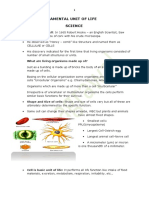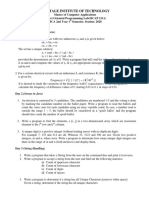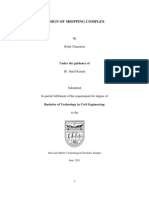Sensitive NH Oh and HCL Gas Sensors Using Self-Aligned and Self-Welded Multiwalled Carbon Nanotubes
Sensitive NH Oh and HCL Gas Sensors Using Self-Aligned and Self-Welded Multiwalled Carbon Nanotubes
Uploaded by
Gurpartap SinghCopyright:
Available Formats
Sensitive NH Oh and HCL Gas Sensors Using Self-Aligned and Self-Welded Multiwalled Carbon Nanotubes
Sensitive NH Oh and HCL Gas Sensors Using Self-Aligned and Self-Welded Multiwalled Carbon Nanotubes
Uploaded by
Gurpartap SinghOriginal Description:
Original Title
Copyright
Available Formats
Share this document
Did you find this document useful?
Is this content inappropriate?
Copyright:
Available Formats
Sensitive NH Oh and HCL Gas Sensors Using Self-Aligned and Self-Welded Multiwalled Carbon Nanotubes
Sensitive NH Oh and HCL Gas Sensors Using Self-Aligned and Self-Welded Multiwalled Carbon Nanotubes
Uploaded by
Gurpartap SinghCopyright:
Available Formats
IEEE SENSORS JOURNAL, VOL. 7, NO.
10, OCTOBER 2007
1435
Sensitive NH3OH and HCl Gas Sensors Using Self-Aligned and Self-Welded Multiwalled Carbon Nanotubes
Massood Tabib-Azar, Senior Member, IEEE, and Yan Xie
AbstractWe present the design and fabrication of sensitive and HCl sensors based on multiand responsive 3 walled carbon nanotubes (MWCNT). The sensors consisted of self-aligned and self-welded MWCNT bridges grown between 18 m-high silicon posts with 26 m gaps using metal-catalyzed chemical vapor deposition technique (CVD). The 510 MWCNTs spanning the gap showed excellent Ohmic electrical contacts and mechanical bonding strengths in excess of 0.1 N/CNT. The conductivity of the MWCNTs changes as oxidizing and reducing gases are physically adsorbed on their large surface-to-volume ratio structures. Since carbon atoms in CNTs do not have any dangling bonds, the interaction between CNTs and gas molecules does not lead to chemical reactions and the process is reversible. Provided that the starting MWCNTs have high resistivity, they have nearly exponential sensitivity in detecting gases and owing to their very small volume and reversible interaction with gases, they can have a very fast response time. In our experiment, upon exposure to ammonia and hydrochloric gases at room temperature, the electrical conductivity of the self-welded carbon nanotube bridges exhibited a dramatic change. The growth process, test results, and the gas sensitivities will be discussed.
NH OH
Fig. 1. Comparison of postprocessed and self-welded CNTs between the electrodes. Self-assembled and self-welded CNTs offer better contact integrity and scalability.
Index TermsBottom-up technique, multiwalled carbon nanotubes (MWCNTs).
I. INTRODUCTION INGLE- AND MULTIWALLED CARBON NANOTUBES (SWCNTs) are being extensively studied [1], [2] for a variety of applications ranging from nanoelectronics (eld-effect Hz nanoelectromechanical resonators, transistors), to to gas and chemical sensors. Given their closed surface structure (almost zero surface/interface traps as a result of lack of dangling bonds) and very large surface-to-volume ratios, both SWCNTs and MWCNTs are ideal for gas/chemical and biosensing applications. Many interesting results are reported regarding various gas sensitivity of CNTs that were post growth aligned with contacts [3], or contacts were deposited over the randomly located CNTs or an electric eld was used to individually grow aligned CNTs between electrical contacts [2]. Most
Manuscript received March 15, 2006; revised May 5, 2007; accepted May 29, 2007. Expanded from a paper presented at the Sensors 2005 Conference. The associate editor coordinating the review of this paper and approving it for publication was Prof. Evgeny Katz. The authors are with the Electrical Engineering and Computer Science Department, Case Western Reserve University, Cleveland, OH 44106 USA (e-mail: tabib-azar@case.edu; yxx15@case.edu). Color versions of one or more of the gures in this paper are available online at http://ieeexplore.ieee.org. Digital Object Identier 10.1109/JSEN.2007.904854
of these techniques either cannot be scaled up or they result in poor alignment and contact properties. Also, the changes that occur in postgrowth aligned CNTs with local probes or in situ aligned using electric elds are usually greatly affected by changes in their contact Schottky barriers that accompanies exposure to gases. Here, we report for the rst time on gas sensors based on self-aligned and self-welded carbon nanotubes between two conducting posts with excellent electrical and mechanical contacts, as shown in Fig. 1. Since the electrical contacts between both sides of the MWCNTs and the silicon posts are intimately formed during the growth process, the gas sensitivity of these self-welded MWCNT devices may be less affected by the contact barrier changes. Also, our technique does not require any electric elds or other externally applied forces, thus it has the potential to be scaled up. Moreover, since the MWCNTs are self-aligned and self-welded during the growth, the only postprocessing steps that are needed are dicing and wire bonding to a chip carrier (package), making these devices inherently more reliable and cost effective. Furthermore, with our technique, MWCNTs can be grown at a relatively low temperature (around 600 C) between conducting silicon or polysilicon posts coated with appropriate layers resulting in enhanced self-welding and CNT growth process. Apart from gas and chemical sensors, the technique can also be tailed for other applications such as constructing nanoscale electronics and optical devices, since ammonia is the only substance in the atmosphere (2 ppm) that neutralizes acidic components such as SO in the air. Also, due to the reason that ammonia is one of the bio by-products in agriculture and medicine, it is in need of careful monitoring. It has been chosen in our study to show the dynamic response of CNT bridges. We also used HCl as an example of acidic components. II. FABRICATION OF THE CARBON NANOTUBE-BASED SENSORS The starting silicon-on-insulator (SOI) posts were dened using photolithography and deep-reactive ion etching, as shown in Fig. 2. These posts were designed with line widths ranging from 1 to 10 m. They were oriented as matching pairs with
1530-437X/$25.00 2007 IEEE
1436
IEEE SENSORS JOURNAL, VOL. 7, NO. 10, OCTOBER 2007
Fig. 2. Scanning electron microscope (SEM) image of the silicon pads connected to silicon posts.
their spacing ranging from 2 to 10 . Each post was connected to a larger area of silicon that had a 150 m square aluminum pad patterned on it. All wafers were sputtered with of aluminum at 750 watts at 5 mT with 10 sccm of 2000 argon. The wafers were subjected to an in situ mild plasma cleaning before the metal deposition. The wafers were patterned with photoresist and the aluminum was wet etched. After cleaning the resist with acetone and methanol, the wafers were patterned again with photoresist for the DRIE process. The SOI wafers were then DRIE etched at an outside facility. m thick. There were The silicon epitaxial layer was two etch requirements due to the 1 m line widths: 1) high anisotropy and 2) no notching at the oxide etch stop. Top-down visual inspection showed the 1 m features all to be intact. Shorter polysilicon structures with only 1 m high posts were also fabricated. The polysilicon wafer was etched in a LAM 490 at 200 watts at 400 mT with 80 sccm of Cl and 120 sccm of He. The polysilicon was 1 m thick and there was an oxide underneath that measured 1000 A thick. After DRIE and Lam etching, the wafers were cleaned with acetone and methanol, and then ashed in an oxygen plasma. The wafers were mounted on blue tape and diced. The above devices were preprocessed to deposit a thin layer of iron on a set of posts and a thin layer of amorphous carbon on the corresponding and opposing posts, as schematically shown in Fig. 3(a). The iron layer (100 ) was deposited off-axis in a thermal evaporator and both CVD amorphous carbon and sputtered carbon layers (50 ) were deposited off-axis. The material deposited with the off-axis deposition was only deposited near the top of the silicon post and was conned to a narrow band. Subsequently, these devices were loaded into a low-pressure chemical vapor deposition (LPCVD) chamber [Fig. 3(b)] and were thermally heated in an argon gas ow to 750 800 in Torr. The heating cycle typically took around 5 min. and The sample temperature was controlled between 600 and the gas ow rates ranged between 0.1 ml/min up to 900 100 ml/min. CNT growth was carried out at Torr. After the sample temperature reached 750 , the acetylene gas (50 sccm) was introduced through an opening located above the chip and CNT growth was carried out with both acetylene and argon gases owing at 50 sccm for 15 min. Subsequently, the acetylene was turned off and the sample was cooled down to room temperature in the argon gas ow (50 sccm). The CNTs were then examined by scanning electron microscope, atomic
Fig. 3. (a) Schematic of the welding process that may occur when the CNT tip grows against the carbon-coated silicon post. The iron particle located at the tip of the CNT becomes in contact with the carbon layer. The carbon atoms from this layer as well as the carbon provided by the gas drive the CNT tip into the carbon layer welding it with large bonding strength. (b) Schematic of the LPCVD chamber used for the CNT growth.
force microscope (Nano-Scope IV) and they were electrically tested by current versus voltage technique (HP 4155B). III. EXPERIMENT RESULTS The samples were examined by scanning electron microscope before and after carbon nanotube growth. The CNTs grew horizontally and parallel to the substrate in the gap between the two silicon posts, as shown in Fig. 4. In this example, there were around ten CNTs bridging the gap and all seemed to be under tension and straight. It is also important to note that the CNTs are only present in the gap region between the posts. This may be caused by the gas current patterns that create a volume slightly richer in feeder gas. We are currently fabricating test structures to examine the origins of this phenomenon further. During the experiment, we also observed that the CNTs only grew between the posts and they are all suspended away from the substrate. Aspects of this behavior is reported in the past and
TABIB-AZAR AND XIE: SENSITIVE
AND HCl GAS SENSORS USING SELF-ALIGNED AND SELF-WELDED MWCNTS
1437
Fig. 4. SEM of self-assembled CNTs grown between silicon posts in the gap region.
explained by the gas ow patterns that exist around the raised posts. In our case, we believe that a combination of surface gas currents and van der Waals interaction are present. First, we note that the CNTs in our case only grew inside the gap and not anywhere else. In [4], it was reported that the CNTs grew everywhere including the gap. In our case, the presence of aluminum contact regions precludes the CNT growth over the contacts. In these regions, as reported by us previously, aluminum acts as a CNT growth poison under certain conditions suppressing the CNT growth. One possible mechanism for this growth suppression is that at 750 , the aluminum is quite soft and starts dissolving the iron nanoparticles diminishing their catalytic ability. Second, we note that the CNTs also do not grow in other regions that are not covered with aluminum, for example, on the walls of the raised SOI region away from the gap. This lack of growth, most probably is caused by the surface currents that generates strong boundary layer shear forces and currents that may cool down these regions below the CNT growth temperature. In between the gap regions, a stagnant volume may exist giving an opportunity for CNTs to grow. The surface current proles, keep the CNT growth conned and directed and away from the bottom surface in these gap regions. The current versus voltage (I-V) characteristics of the CNTs measured by contacting the 150 m pads is shown in Fig. 5. It is interesting to note that the I-V is very symmetric with a deection region near the origin that is related to the band gap of the CNT. The symmetry of the I-V indicates that the two electrical contacts at the two ends of the CNT bridges are nearly identical. Thus, the growth side and welded side are electrically the same. There were approximately ten CNTs in this device resulting around 10 nA/CNT current conduction at 0.5 V. The resulting current densities at 0.5 V and assuming CNT diameter of A/cm . In electric eld-asaround 10 nm, was around sisted growth, as well as AFM-assembled CNT devices, the I-Vs are usually asymmetric indicating different contact characteristics on the two ends of the CNTs. To examine the strength of the bond between the CNT and electrode, the AFM technique was used to image, locate, and then apply a vertical force on the CNT to measure the bond strength. We used AFM probes with a 0.02 N/m spring constant and ultra-sharp tips. The tip was then positioned at the midpoint between two posts over the CNT and 110 nm vertical steps were successively applied, while measuring the force using the AFM system. The resultant load deformation plot is shown in Fig. 6. After AFM testing, the device was imaged with SEM and it
Fig. 5. Current versus voltage characteristic of the CNTs. There were approximately ten CNTs spanning the gap. The I-V is symmetric indicating nearly identical contacts between the CNTs and the silicon posts. The CNT band-gap characteristic is evident near the origin.
Fig. 6. Load-deection characteristics of the self-welded self-aligned MWCNTs. The peak force before breaking of some of the MWCNT walls and telescoping occurred at 1:96 10 N.
appeared that the CNTs were stretched and telescoped out after the initial breaking of some of this walls as also reported by other in MWCNTs [5]. The load-deformation plot shown in Fig. 6 indicates that after the initial contact, the rst 110 nm displacement resulted in a force of around 196 nN before the nanotube length was modied either due to telescoping effect or breaking during the second 110 nm displacement step. Self-welded silicon nanowires with similar structures broke at 75 nN level [6]. The initial slope of the load-displacement curve from Fig. 6 is 1.48 N/m. Taking the CNT diameter to be around 10 nm and its young modulus around 1.25 TPa [7], the effective Hookes constant at midpoint N/m. So, the apparently loading should be around large slope of 1.48 N/m is due to the maximum stress afforded by the welded CNT contacts on both ends. Theoretical studies have predicted signicant changes in the electronic properties of carbon nanotubes because of gas absorption. To show the feasibility of using our devices as high sensitivity gas and chemical sensors, the response of carbon nanotube bridges to different gases were evaluated by monitoring the change of the resistance of carbon nanotubes upon exposure to NH H and HCl. The current through the CNTs was reduced upon exposure to ammonia and hydrochloric gases, as can be seen in Fig. 7(a) and (b). For ammonia, the response time
1438
IEEE SENSORS JOURNAL, VOL. 7, NO. 10, OCTOBER 2007
molecules and the associated charge-transfer processes. There is another possible mechanism contributing to the conductivity change upon gas absorption. As we know, multiwalled nanotubes are basically 2-D structures consisting of multiple concentrically nested carbon tubes, similar to the rings of a tree trunk. The gas molecules absorbed and attached to the outer surface of the multiwalled carbon nanotubes may deform the outer layer and shift the lattice arrangement between the outer layer and inner layer of the MWNTs, thus affecting their transport property. In summary, we have demonstrated the growth of lateral-oriented and self-welded carbon nanotubes by using metal catalyzed chemical vapor deposition without applying any electric eld or external force. The carbon nanotube bridges formed between silicon posts are mechanically robust as conrmed by the atomic force microscope measurement. The fact that a drastic change in the CNT conductivity in the presence of ammonia and HCl (gas) was observed shows the feasibility of using our self-welded nanostructure as a basis of very sensitive CNT gas sensors. This structure also offers the possibility of fabricating novel nanoscale electronics and optical devices efciently and costly.
Fig. 7. (a) I-V of the CNT device (1) before, (2) during, (3) and after exposure to ammonia. (b) I-V of the CNT device (1) before and (2) after exposure to HCl gas.
REFERENCES
[1] M. Tabib-Azar and Y. Xie, Self-welded metal-catalyzed carbon naotube bridges, Appl. Phy. Lett., 2005, submitted for publication. [2] P. G. Collins, K. Bradley, M. Ishigami, and A. Zettl, Extreme oxygen sensitivity of electronic properties of carbon nanotubes, Science, vol. 287, p. 1801, 2000. [3] J. Suehiro, G. Zhou, and N. Hara, Fabrication of carbon nanotubebased gas sensor using dielectrophoresis and its application for ammonia detection by impedance spectroscopy, J. Phys. D: App. Phys., vol. 36, p. L109, 2003. [4] Y. Homma, Y. Kobayashi, T. Ogino, and T. Yamashita, Growth of suspended carbon nanotube networks on 100-nm scale silicon pillars,, Appl. Phy. Lett., vol. 81, p. 2261, 2002. [5] C. Thelander, M. H. Magnusson, K. Deppert, L. Samuelson, P. R. Poulsen, and J. Nyga, Gold nanoparticle single-electron transistor with carbon nanotube leads, Appl. Phy. Lett., vol. 79, p. 2106, 2002. [6] K. B. K. Theo et al., Fabrication and electrical characteristics of carbon nanotube-based microcathodes for use in a parallel electron-beam lithography system, J. Vac. Sci. Technol., vol. B21, p. 693, 2003. [7] T. A. El-Aguizy, J.-H. Jeong, Y. B. Jeon, W. Z. Li, Z. F. Ren, and S.-G. Kim, Transplanting carbon nanotubes, Appl. Phy. Lett., vol. 85, p. 5995. [8] O. K. Varghese, P. D. Kichambre, D. Gong, K. G. Ong, E. C. Dichey, and C. A. Grimes, Gas sensing characteristics of multi-wall carbon nanotubes, Sens. Actuators B, vol. 8, p. 32, 2001. [9] K. Kaneto, M. Tsuruta, G. Sakai, W. Y. Cho, and Y. Ando, Electrical conductivities of multi-wall carbon nano tubes, Synth. Metals, vol. 103, p. 2543, 1999. [10] Y. Fan, M. Burghard, and K. Kern, Chemical defect decoration of carbon nanotubes, Adv. Mater., vol. 2, p. 130, 2002. Massood Tabib-Azar (S83M86SM93) received the M.S. and Ph.D. degrees in electrical engineering from the Rensselaer Polytechnic Institute (RPI), Troy, NY, in 1984 and 1986, respectively. During the 1986 to 1987 academic year, he was an Instructor with the Department of Electrical and Computer Science Engineering (ECSE), RPI. In 1987, he joined the faculty of the Department Electrical Engineering and Computer Science, Case Western Reserve University (CWRU), Cleveland, OH. During the summers of 1991 and 1992, he was a Fellow with the National Aeronautics and Space Administration (NASA). From 1993 to 1994, he was on sabbatical leave with Harvard University, and from 2000 to 2001, with Yale University. He is currently a Professor with the
was faster than 2 s when the ammonia was rst introduced. It took around 60 s for the current to become larger again. The asymmetry of the I-V curve shown in Fig. 7(a) suggests differential modication of the CNT contacts. This is undesirable and will be investigated further. The effect of HCl was smaller. Upon exposure to HCl, the response time was faster than 10 s. It took a much longer time for it to recover. During the experiment, the CNT device was inside a closed petry dish at room temperature and a small vial containing NH OH or HCl were separately introduced inside the petry dish allowing the gas molecules to spread at the partial pressures of these substances. The electrical response of the self-welded CNT bridges to different gases can be explained by the following mechanisms. Due to the overlapping of conduction and valence bands of different carbon layer, at room temperature, MWNTs usually show a metallic behavior. However, some MWNTs also have conductivity values in the semiconducting range. This phenomenon has been veried by the experimental results from several groups [8], [9]. In our case, the self-welded CNT bridges might also be semiconducting ones. For these self-welded semiconducting CNTs, the electronic properties of their surface can be altered due to the charge transfer induced by the absorption of gas molecules. When setting the sensor in different gases, some gases will extract electrons from the CNTs, thus acting as acceptors and some gases can release electrons to CNTs, thus acting as donors. In our experiment, the starting MWCNTs were exposed to air and are very likely low resistivity p-type. Both NH OH and HCl seemed to act as donors compensating for the whole concentration and reducing their conductance. The defects on the surface of CNTs may also contribute to the CNTs capability of gas sensing. These local defects existing in different forms not only increase CNTs overall conductance [10] but can also provide a preferred location for interactions with gas
TABIB-AZAR AND XIE: SENSITIVE
AND HCl GAS SENSORS USING SELF-ALIGNED AND SELF-WELDED MWCNTS
1439
Department of Electrical Engineering and Computer Science (EECS), CWRU, with joint appointments with the Macromolecular Engineering and Physics Departments. His current research interests include nanometrology tools (microwave-atomic force microscopy), molecular electronics, novel devices based on solid electrolytes, sensors and actuators, and quantum computing. His teaching interests include development of courses in the area of electronic device physics and electromagnetics with an emphasis on solving problems and the use of computer-aided instruction tools. He has authored three books, two book chapters, over 110 journal publications, and numerous conference proceeding papers. Dr. Tabib-Azar was a recipient of the 1991 Lilly Foundation Fellowship. He was also the recipient of over ten certicates of appreciation and recognition for his professional activities and a Best Paper Award presented at the 2001 Design Automation Conference for his work on electromagnetic properties of interconnects and defects in integrated circuits (ICs). He is a member of the New York Academy of Sciences, IEEE Electron Devices Society, the IEEE Antennas and Propagation Society (IEEE AP-S), the Association of Asphalt Paving Technologists (AAPT), and Sigma Xi. He has introduced and chairs numerous international symposia in his elds of interest.
Yan Xie was born in China in 1978. He received the B.S. degree from the Department of Precision Instrument, Shanghai Jiao Tong University, Shanghai, China, in 2001 and the M.S. degree from the Department of Electrical Engineering, Case Western Reserve Univerisity (CWRU), Cleveland, OH, in 2006. He is currentlyworking towards the Ph.D. degree at the Department of Electrical Engineering, CWRU. His primary research insterest is fabrication and characterization of nanoscale structures.
You might also like
- Final PPT of Carbon NanotubesDocument29 pagesFinal PPT of Carbon Nanotubesmkumar_5481467% (3)
- C C++ in UrduDocument160 pagesC C++ in Urdumigatron74181% (32)
- 02 Apl 5Document3 pages02 Apl 5Vinita ChoudharyNo ratings yet
- Carbon Nanotubes-Properties and ApplicationsDocument6 pagesCarbon Nanotubes-Properties and ApplicationsJack PopNo ratings yet
- Carbon Nanotube Synthesis ReportDocument7 pagesCarbon Nanotube Synthesis ReportSrikanth ReddyNo ratings yet
- Nanostructure Engineered Chemical Sensors For Hazardous Gas and Vapor DetectionDocument11 pagesNanostructure Engineered Chemical Sensors For Hazardous Gas and Vapor Detectionbweaver700No ratings yet
- CNT PaperDocument7 pagesCNT PaperAustin LaneNo ratings yet
- Carbon Nanotubes:: Next Generation of Electronic MaterialsDocument4 pagesCarbon Nanotubes:: Next Generation of Electronic MaterialsSatheesh ChandranNo ratings yet
- Arc Discharge Laser Ablation Chemical Vapor DepositionDocument6 pagesArc Discharge Laser Ablation Chemical Vapor DepositionsreekanthsharmaNo ratings yet
- 3.field FullDocument8 pages3.field FullTJPRC PublicationsNo ratings yet
- (O) (H) Functionalization On Carbon Nanotube Using (O - H) Gas Mixture DC Glow DischargeDocument9 pages(O) (H) Functionalization On Carbon Nanotube Using (O - H) Gas Mixture DC Glow DischargeTamilmany K ThandavanNo ratings yet
- Carbon Nanotubes (CNT)Document9 pagesCarbon Nanotubes (CNT)Oshi_TweetyNo ratings yet
- NanomaterialsDocument10 pagesNanomaterialsDorothy SaikiaNo ratings yet
- LECTURE 15-3: Carbon Nanostructures: Fullerenes and Carbon NanotubesDocument28 pagesLECTURE 15-3: Carbon Nanostructures: Fullerenes and Carbon NanotubesSk. Laila AyeshaNo ratings yet
- Carbon Nanotubes: Centre For Nanoscience and Technology, Pondicherry University Puducherry-605 014, IndiaDocument62 pagesCarbon Nanotubes: Centre For Nanoscience and Technology, Pondicherry University Puducherry-605 014, IndiaMohammad RameezNo ratings yet
- Nanotubes by CVD and ApplicationsDocument9 pagesNanotubes by CVD and ApplicationsGovind RajanNo ratings yet
- An Increase in Gas Sensitivity and Recovery of An MWCNT Ba 2010 Chemical PhyDocument5 pagesAn Increase in Gas Sensitivity and Recovery of An MWCNT Ba 2010 Chemical PhyWahaj KhanNo ratings yet
- Fe O - CNT Nanocomposite For Binary Gas Detection Monika Joshi, R.P Singh & Vidur RajDocument5 pagesFe O - CNT Nanocomposite For Binary Gas Detection Monika Joshi, R.P Singh & Vidur RajVidur Raj SinghNo ratings yet
- Production of Carbon NanotubesDocument16 pagesProduction of Carbon NanotubesNyla Vaidya100% (1)
- 2.detection FullDocument8 pages2.detection FullTJPRC PublicationsNo ratings yet
- Diameter-And Length-Dependent Self-Organizations of Multi-Walled Carbon Nanotubes On Spherical Alumina MicroparticlesDocument12 pagesDiameter-And Length-Dependent Self-Organizations of Multi-Walled Carbon Nanotubes On Spherical Alumina MicroparticlesFAEZENo ratings yet
- Kompakt, Apr 2011Document4 pagesKompakt, Apr 2011emediageNo ratings yet
- The Specific Heat and Effective Thermal ConductiviDocument8 pagesThe Specific Heat and Effective Thermal Conductiviماهر مرشد حمد الشمريNo ratings yet
- Modeling of Carbon Nanotube Field Effect Transistors: HCM City University of Natural Sciences, VietnamDocument26 pagesModeling of Carbon Nanotube Field Effect Transistors: HCM City University of Natural Sciences, VietnamshwetaNo ratings yet
- Nanoscopic Carbon Electrodes CARBON RevisedDocument24 pagesNanoscopic Carbon Electrodes CARBON Revisedabdellahbe41No ratings yet
- Carbon NanotubesDocument3 pagesCarbon NanotubesManigandan GanesanNo ratings yet
- tmpB0C7 TMPDocument5 pagestmpB0C7 TMPFrontiersNo ratings yet
- CNT TransistorDocument27 pagesCNT TransistorshNo ratings yet
- Composites: Part B: Chih-Chun Teng, Chen-Chi M. Ma, Kuo-Chan Chiou, Tzong-Ming LeeDocument7 pagesComposites: Part B: Chih-Chun Teng, Chen-Chi M. Ma, Kuo-Chan Chiou, Tzong-Ming LeeamirswtNo ratings yet
- Effects of CVD Direct Growth of Carbon Nanotubes and Nanofibers On Microstructure and Electrochemical Corrosion Behavior of 316 Stainless SteelDocument13 pagesEffects of CVD Direct Growth of Carbon Nanotubes and Nanofibers On Microstructure and Electrochemical Corrosion Behavior of 316 Stainless SteelelucidatorNo ratings yet
- Carbon Nanotubes: Himanshu Tyagi, Diwakar Prasad, Deepak Kumar, DR - Leena AryaDocument4 pagesCarbon Nanotubes: Himanshu Tyagi, Diwakar Prasad, Deepak Kumar, DR - Leena AryaRavindra KumarNo ratings yet
- Shahidi 2018Document15 pagesShahidi 2018haseebbalu6No ratings yet
- Carbon Nanotubes Properties and ApplicationsDocument16 pagesCarbon Nanotubes Properties and ApplicationsBarani BaraniNo ratings yet
- 3 - Carbon Nanotubes-Alzuraiqi (SAMPLE 2)Document2 pages3 - Carbon Nanotubes-Alzuraiqi (SAMPLE 2)Abdullah Al-AsiriNo ratings yet
- Carbon NanotubeDocument23 pagesCarbon NanotubeDiavolo RequiemNo ratings yet
- Synthesis of Ammonia Gas Sensor Based On Multiwalled Carbon Nanotube and Schiff Base PolymerDocument43 pagesSynthesis of Ammonia Gas Sensor Based On Multiwalled Carbon Nanotube and Schiff Base Polymermohammed mahadi.aNo ratings yet
- Friction and Wear Behaviour of Ni Coated CNTDocument5 pagesFriction and Wear Behaviour of Ni Coated CNTnarayanan1701_318170No ratings yet
- In Situ Synthesis of Super-Long Cu Nanowires Inside Carbon Nanotubes With Coal As Carbon SourceDocument3 pagesIn Situ Synthesis of Super-Long Cu Nanowires Inside Carbon Nanotubes With Coal As Carbon SourceRamon Roman DovalNo ratings yet
- Carbon NanotubesDocument15 pagesCarbon NanotubesLaraib HabibNo ratings yet
- Carbon Nanotube Assembly and Integration For AppliDocument47 pagesCarbon Nanotube Assembly and Integration For Applijorge montes gutiérrezNo ratings yet
- Nano Technology: Origin The Term Nanotechnology' Is Derived From The Greek Word Nanos'Document30 pagesNano Technology: Origin The Term Nanotechnology' Is Derived From The Greek Word Nanos'SaiKishoreNo ratings yet
- 2017 - SWCNH-Review On Synthesis-Properties-ApplicationsDocument9 pages2017 - SWCNH-Review On Synthesis-Properties-ApplicationsDaniela NastacNo ratings yet
- Carbon Nano TubeDocument9 pagesCarbon Nano TubeJeffrin MichaelNo ratings yet
- 2004-Carbon Nanotube FiltersDocument5 pages2004-Carbon Nanotube FiltersRutvij KotechaNo ratings yet
- 2015L - Síntese e Caracterização em Uma Etapa de Um Nanocompósito Baseado em Nanotubos de CarbonoDocument9 pages2015L - Síntese e Caracterização em Uma Etapa de Um Nanocompósito Baseado em Nanotubos de CarbonoIgor Alexsander Barbosa MagnoNo ratings yet
- Experimental DetailsDocument13 pagesExperimental DetailsMuhammad KafillahNo ratings yet
- CNT Nano Sensors Simulation in DrdoDocument55 pagesCNT Nano Sensors Simulation in DrdohimanshuNo ratings yet
- AUTODocument20 pagesAUTOJayaananth GopalaswamyNo ratings yet
- Quantum Interference in A One-Dimensional Silicon NanowireDocument6 pagesQuantum Interference in A One-Dimensional Silicon NanowireAleandro AntidormiNo ratings yet
- Capture and Tunnel Emission of Electrons by Deep Levels in Ultrathin Nitrided Oxides On SiliconDocument4 pagesCapture and Tunnel Emission of Electrons by Deep Levels in Ultrathin Nitrided Oxides On SiliconVishwas Nitre GopinathNo ratings yet
- Monitoring The Concentration of Carbon Dioxide by Measuring The Change in The Resistance of Tio Nanowires Doped With PotassiumDocument21 pagesMonitoring The Concentration of Carbon Dioxide by Measuring The Change in The Resistance of Tio Nanowires Doped With Potassiumnamshinchoi47No ratings yet
- TV Guide, May 2011Document4 pagesTV Guide, May 2011emediageNo ratings yet
- A Carbon Nanotube-Reinforced Noble Tin Anode Structure For Lithium-Ion BatteriesDocument8 pagesA Carbon Nanotube-Reinforced Noble Tin Anode Structure For Lithium-Ion BatteriesdiskysmNo ratings yet
- Carbon Nanotubes in Microelectronic ApplicationsDocument11 pagesCarbon Nanotubes in Microelectronic ApplicationsHanumanth D B KplNo ratings yet
- Carbon Nanotube ArraysDocument5 pagesCarbon Nanotube ArraysDjoko JohnNo ratings yet
- Carbon NANOTUBE As A InterconnectDocument40 pagesCarbon NANOTUBE As A InterconnectPraveen YsNo ratings yet
- Methods For Carbon Nanotubes Synthesis RDocument13 pagesMethods For Carbon Nanotubes Synthesis RM SHOAIB KHALIDNo ratings yet
- Synthesis of Carbon Nanotubes: Journal of Nanoscience and Nanotechnology November 2005Document66 pagesSynthesis of Carbon Nanotubes: Journal of Nanoscience and Nanotechnology November 2005Anonymous uWJegzuFxNo ratings yet
- Structure-Dependent Electrical Properties of Carbon Nanotube FibersDocument6 pagesStructure-Dependent Electrical Properties of Carbon Nanotube FibersAlexis HernandezNo ratings yet
- Simulation of Transport in NanodevicesFrom EverandSimulation of Transport in NanodevicesFrançois TriozonNo ratings yet
- Nda 3Document36 pagesNda 3Gurpartap SinghNo ratings yet
- To Crop by Mouse Pointer Void Mousehandler (Int Event, Int X, Int Y, Int, Void ) (Document7 pagesTo Crop by Mouse Pointer Void Mousehandler (Int Event, Int X, Int Y, Int, Void ) (Gurpartap SinghNo ratings yet
- Electronic Properties of Single-Wall Carbon Nanotubes and Their Dependence On Synthetic MethodsDocument5 pagesElectronic Properties of Single-Wall Carbon Nanotubes and Their Dependence On Synthetic MethodsGurpartap SinghNo ratings yet
- Copy of Skills Base ResumeDocument2 pagesCopy of Skills Base ResumeGurpartap SinghNo ratings yet
- Microcontroller Chapter1Document13 pagesMicrocontroller Chapter1Neelam KapoorNo ratings yet
- ABS 5. 3 BOSCH Braking System Training Board - Simulator: Technical Specifications and FunctionsDocument1 pageABS 5. 3 BOSCH Braking System Training Board - Simulator: Technical Specifications and FunctionsFaziri Abdul HaqNo ratings yet
- SA-AMI-000-HECM-620200 - CALCULATION FOR SHEET PILES CALCULATIONS FOR COOLING WATER PIPE - Rev1Document10 pagesSA-AMI-000-HECM-620200 - CALCULATION FOR SHEET PILES CALCULATIONS FOR COOLING WATER PIPE - Rev1nurtureherbNo ratings yet
- SOP ElectrocardiographsDocument7 pagesSOP ElectrocardiographsDodik E. PrasetyoNo ratings yet
- Daily Lesson Plan: Marigondon National High SchoolDocument2 pagesDaily Lesson Plan: Marigondon National High SchoolIrene AngNo ratings yet
- Skill Matrix TemplateDocument11 pagesSkill Matrix TemplateAhmed AbozeadNo ratings yet
- MT ProcedureDocument22 pagesMT Procedureefmartin21No ratings yet
- Q2 MIL 4a Visual Information and Media Part 1Document34 pagesQ2 MIL 4a Visual Information and Media Part 1MJ NatividadNo ratings yet
- Mathematics Computational Msthrmstics MA1101 - Tutorial2 Contact Naresh Sehdev 8527018189Document2 pagesMathematics Computational Msthrmstics MA1101 - Tutorial2 Contact Naresh Sehdev 8527018189Naresh SehdevNo ratings yet
- Ch-5: The Fundamental Unit of Life Class-Ix ScienceDocument12 pagesCh-5: The Fundamental Unit of Life Class-Ix Scienceapi-400692183100% (1)
- 15-Frictional Properties of Fibers.Document21 pages15-Frictional Properties of Fibers.Fahad HussainNo ratings yet
- Teknik Menjawab Soalan MatematikDocument22 pagesTeknik Menjawab Soalan Matematiknasrun21No ratings yet
- F33K100H/3E: Technical DataDocument3 pagesF33K100H/3E: Technical DataproshoNo ratings yet
- Java Lab Assignment, 2020Document4 pagesJava Lab Assignment, 2020Pritam Basu50% (2)
- Skema BK2 KimiaDocument12 pagesSkema BK2 KimiaazmiNo ratings yet
- RIPASA Score For Diagnosis of AADocument6 pagesRIPASA Score For Diagnosis of AANico CabreraNo ratings yet
- QP - End Semester - ME150Document3 pagesQP - End Semester - ME150Samar SinghalNo ratings yet
- BUS 202 Solution Midterm SyllabusDocument23 pagesBUS 202 Solution Midterm SyllabusNavid Al Faiyaz Provi0% (1)
- 2300 Technical Manual 2300 LastDocument17 pages2300 Technical Manual 2300 LastАнатолий ПетренкоNo ratings yet
- Lec 8 - Polish Notation 24102022 101228amDocument17 pagesLec 8 - Polish Notation 24102022 101228amdoodhjaleybiNo ratings yet
- Forward Chaining and Backward ChainingDocument11 pagesForward Chaining and Backward ChainingMonir AhammodNo ratings yet
- Electroanalytical ChemistryDocument31 pagesElectroanalytical Chemistryyouni_2005No ratings yet
- Manipulator Kinematics - Example - 3R: MECH 498: Introduction To Robotics Inverse Manipulator Kinematics M. O'MalleyDocument50 pagesManipulator Kinematics - Example - 3R: MECH 498: Introduction To Robotics Inverse Manipulator Kinematics M. O'MalleyRahulGP88% (8)
- Design of Shopping ComplexDocument100 pagesDesign of Shopping ComplexRohit Chaurasia100% (1)
- TDS Water FluxDocument2 pagesTDS Water FluxVinit ShrivastavaNo ratings yet
- GCE AS Level Representation of Data Cumulative Frequency GraphDocument9 pagesGCE AS Level Representation of Data Cumulative Frequency GraphHANSNo ratings yet
- ROOFFANSDocument124 pagesROOFFANSLuiz CostaNo ratings yet
- Onkyo - C 701 ADocument21 pagesOnkyo - C 701 Anyoman dundunNo ratings yet
- SolutionDocument4 pagesSolutionElvin BucknorNo ratings yet



